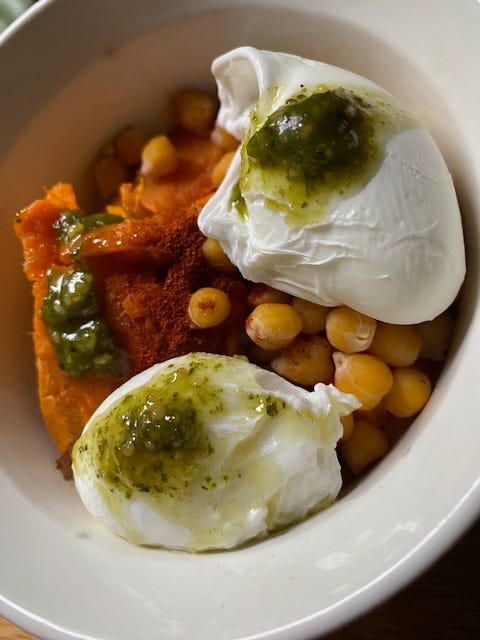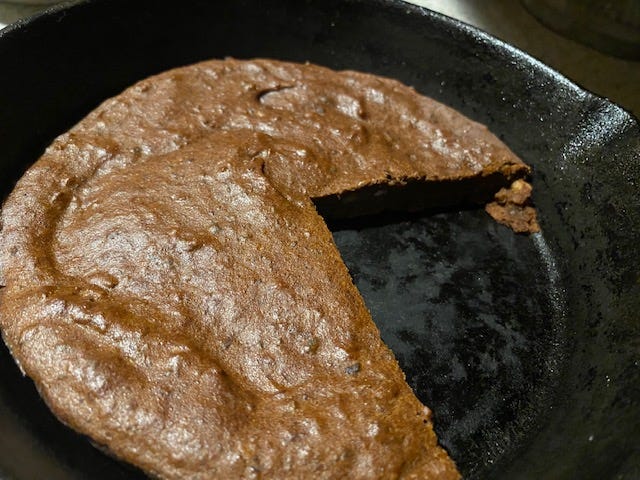19 ways I optimize nutrient-centered meal planning
Food feels like a lifestyle to me, so I create a meal plan each week.
Meal planning is a polarizing topic. Some people love it. I’ve gone through spells in my life when there wasn’t enough time or energy to cook a meal, let alone plan a week’s worth. But most of the time, food feels like a lifestyle to me. I look forward to each meal. Knowing what’s coming gives me peace of mind, helps make each dollar spent on food work (allows the money saved to be invested), and gives me more to look forward to. When I don’t have a meal plan, I end up feeling flustered in the day’s inertia, then try to shoehorn random ingredients together, order takeout, or waste food because it went past its prime.
Years ago, a friend asked me how I meal plan. I showed her my hand-drawn Sunday through Saturday chart that I write on scrap paper each week. I know some folks prefer to list out all breakfasts, lunches, and dinners—I prefer to write each of those meals by day. I have a better sense of how ingredients may repeat and the age of ingredients that way (if I’m incorporating leftovers). When I showed her my week-long list she said, “That’s it?” I’m not sure what she was expecting. It’s each day with each meal. A meal plan. Just to set your expectations, that’s how I think of a meal plan and that’s what I’m sharing today along with questions that I ask myself as I plot ingredients and figure out the week.
For an introvert, alone time is nutritious in and of itself.
The meal plan I’m using as an example is Monday through Friday from a recent week that I spent at home alone while my husband was away. When he’s home, he usually talks me into a night of takeout or a dinner out. When I’m home alone, my introverted heart wants nothing to do with anyone and nowhere to go. I would rather eat a can of tuna by itself than order takeout if I was too tired to cook and it meant more time by myself. For an introvert, alone time is nutritious in and of itself.
Some things I don’t do when thinking through meals for us: counting calories, macros, catering to food allergies or dietary restrictions. As a personal preference, I also don’t repeat a meal both back-to-back and meal-to-meal. This means I won’t have pizza for lunch and then again at dinner. It also means I won’t have scrambled eggs for breakfast two days in a row. I crave variety and look forward to different flavors and ingredients. I know some folks find comfort in having the same cereal day after day. I understand that—and it would make for easy meal planning and budgeting!—but I’ve learned that I look forward to variety the most.
4 questions I ask to make meal planning more efficient
One of the first questions I ask myself is, “What do I have going on this week?” If I’m in an all-day meeting, I know I’m not coming home to make paella. It will likely be a Crock-Pot night. I’ll mark days where I know I need less complicated or reheatable meals in anticipation of Tired Future Me.
What’s the weather? Depending on the season, this will tell me to prioritize certain garden ingredients. For instance, I might plan tomato harvests and tomato-based meals on certain days if I see that a storm is coming through, which could threaten splitting the fruits. The weather also signals to me when I should harvest other ingredients. Thunderstorms Wednesday afternoon? I’m not going to harvest a salad or beans in that weather, so I’ll need to cut my ingredients that morning or a day or two before.
What’s in the freezer, pantry, or garden (in season)? I’m not going to plan meatballs and spaghetti if I don’t have ground beef or pasta. The cuts of meat in the freezer and what’s in the pantry will determine the meal. Using what we have from the freezer helps reduce our food expenses. Between the pork, chicken, and quail we raised over the past year, we don’t have to purchase other meats. I still buy grass-fed beef, bison, venison, fish and shellfish, and other meats because (again) I love variety and the different protein sources offer a wider range of nutrients. (More on that in my nutrients question section.)
Which meatless meals will I make this week? (I shoot for 2 or 3 meatless dinners mainly for variety and cost savings.) I have a handful of plant-based meals that I rotate through, some include an enchilada bake, enchiladas, pasta primavera, quiche, and pizza.
6 questions I ask to make meal planning more nutritious
Meat and meat products are among the most nutrient-dense food sources in the human diet. - NUTRIENTS, May 2024
Does each meal contain something in season? One of my favorite YouTubers, Roots and Refuge Farm, has a great saying, “Store bought tomatoes taste like disappointment. Grow your own.” In-season foods taste better and repeatedly show higher nutritive properties, especially if you’re consuming them closer to harvest time. Over the past few years, I’ve moved closer to seasonal eating, declining certain foods when I know they’re out of season, or avoiding them when I see them on restaurant menus. It’s made me thrilled for strawberry season, blueberry season, and I can’t describe the joy I felt when I saw one of my favorite mountain orchards in Western North Carolina flip their “Open” sign up this past week. (Barber Orchards is only open August through December. Seeing the sign made me squeal.) While it would be great if I pulled something seasonal into each meal, I strive to hit a daily mark instead.
Am I including 30 different plants this week? ZOE Science and Nutrition co-founder and professor Tim Spector recommends targeting 30 plants per week. According to ZOE, “Studies still suggest that eating 5 portions of fruit and vegetables a day can have a significant positive impact on your long-term health.
But many experts now believe that eating a variety of plants could be just as important….eating a variety of plant foods is also important for the health of your gut microbiome…a more diverse microbiome, rich in beneficial bugs, has links to a better functioning and more resilient gut. Some scientists think it may even help you live a longer and healthier life.” Herbs count toward the variety, so grabbing some sprigs and adding to each meal adds up.
Are these primarily whole foods? We’re definitely one of those “ingredients households”, so I’ve set myself up where I only have certain things available to cook with. I remember years ago I was making tacos for dinner. When it came time to add the taco seasoning, I realized I didn’t have one of those pre-made taco seasoning packets from the grocery store. At the time, I thought I couldn’t cook tacos without it, so I morphed the meal into something else. It wasn’t until years later I saw someone sharing their taco seasoning recipe on Instagram and the light bulb when off—Oh, I can make my own. Then I read the seasoning packet’s label and realized it was full of preservatives and corn derivatives.
Do I have at least 2 or 3 protein sources in each meal? This is a newer question for me. I started asking myself this question earlier this year. In the past, I had a primary protein source for a meal, but as I learn more about the protein intake benefits for people of all ages—but particularly women my age—I’ve started prioritizing it. Instead of pasta and veggies, I’ll add white beans, an egg, and an aged cheese. The layers and varieties of protein work synergistically. When incorporating more protein, we not only help to stabilize and maintain blood sugar levels, but each food can help make another food’s nutrients more bioavailable.
Am I cooking with more than 3 different types of meat? I look for varying meat sources both to support my love for food diversity, but also to make sure we’re offering our bodies a range of amino acids, minerals, fats, and vitamins. I’m not a fan of eating liver, but it’s the most nutritious meat on earth. I’ll add homemade “liver sprinkles” to dishes to help boost their nutrient content while not sacrificing flavor. I also try to add game or a more exotic meat each month. Whether it’s venison, elk, wild boar, or ostrich—cooking with different meats is fun to me, helps activate beneficial bacteria in our gut microbiome, and makes other nutrients available to our bodies. A few months ago, NUTRIENTS published, “Meat and meat products are among the most nutrient-dense food sources in the human diet. They fulfill most of our bodily requirements, acting as important sources of energy and a variety of essential nutrients, such as high-quality protein, several micronutrients (such as readily bioavailable iron, zinc, and selenium), vitamins (B6, B12, and folic acid), and bioactive compounds (taurine, carnitine, carnosine, ubiquinone, glutathione, and creatine) which are needed for a whole series of metabolic functions. Meat and meat products played a vital role in human evolution and are important components of a healthy and well-balanced diet.” Since nutrition can vary widely with how the animal was raised and what it was fed (see my earlier post about the nutritional values of pastured pork), sourcing animals raised in ethical and health-supportive conditions can help ensure greater nutrient potential in a meal. According to ANIMAL FRONTIERS, “Nutrient levels vary considerably between categories of meat (e.g., ruminant meat, pork, poultry, and processed meats), as well as carcass cuts and fattiness. These differences can be further modulated by animal genetics, activity level, sex, and feed.” Sourcing diverse meat sources and cooking with varying cuts helps create a nutrient buffet of sorts.
Have I included beans today? I try to incorporate a different bean at least with dinner each day, most days. The fiber content helps to slow digestion and keep blood sugar levels steady, plus it helps feed microbiota and improve cardiac health. According to ZOE, “Research consistently shows that beans can have a positive impact on heart health. Their fiber, potassium, folate, and antioxidants can lower blood pressure…which may decrease the risk of heart disease.”
5 things I do to boost nutrition with meals:
Chop garlic in advance. Letting chopped garlic sit for at least 10 minutes allows it to oxidize and releases beneficial compounds. I also add it at the end of cooking or add it raw to a dipping oil so that it retains as many of those compounds as possible.
Consume protein first. Eating carbs first spikes blood sugar. By eating the protein and fat sources first, we help prevent blood sugar spikes, slow digestion, and release gut hormones that signal we’re full.
Soak beans or grains (ideally in bone broth). I was chatting with a friend recently and somehow got on the topic of beans. I complained how it takes so long to soak them and such a long cook time. She had never in her life cooked dried beans. She has always used canned beans. I have both available, but I save the canned versions for days when I forget (or feel too tired) to soak and cook them. Meal planning helps me see which nights I need to start soaking beans and grains. Take a peek at my earlier post about boosting the nutrient content of leftovers, which shares research that reheated pre-cooked grains actually have more nutrients. Varieties of grains I cook with aside from pasta: rice (at least 3 different kinds), quinoa (also several kinds), millet, kamut, farro, and barley.
Incorporate naturally-leavened breads when possible. Fermented dough helps improve beneficial bacteria in the gut and uses fewer resources (no commercial yeast needed).
Cook with cast iron or stainless steel. Opting for these cookware surfaces helps avoid toxins in nonstick cookware, plus cooking with cast iron has shown to increase iron content in cooked food by up to 16 percent.
Considering all of these questions and factors, here’s how I cooked for myself for a week and targeted 30 plants:
Monday (20 different plants)
Smoothie: Banana, blueberries, peanut butter, cacao powder, 1 egg (raw), chia seeds, flaxseed, homemade cashew milk
Leftovers from dinner the night before: pasta with white beans, spinach, pesto, 1 egg
Sesame-peanut-garlic chicken breast (leftover from freezer) with garbanzo beans, quinoa, and sweet potato
Snacks: Fresh peaches and pecans, chia pudding with cashew milk, maple syrup, and homemade vanilla extract

Tuesday (4 more different plants)
Pesto poached eggs, sweet potato, garbanzo beans
Bone broth with leftover quinoa and roast chicken breast (thawed leftovers from freezer)
Rice bowl: brown rice, ham (leftover from freezer), white beans, garlic, 1 egg, green beans
Snacks: Pear and walnuts, homemade black bean brownies
Wednesday (3 more different plants)
Coffee and a leftover black bean brownie
Leftover rice bowl from dinner the night before
Steak, roasted potatoes, sliced tomato from the garden with salt, homemade sourdough bread with extra-virgin olive oil and garlic
Thursday (5 more different plants)
Homemade sourdough English muffins (dough fermented overnight in fridge), 1 over-medium egg, fresh-picked blueberries
Smoothie (same as Monday’s breakfast)
Pork cheek taco bowl with red beans, kamut, and tomatillo salsa

Friday (2 more different plants)
Egg white scramble (3 eggs), English muffin, blueberries
(I had to run an errand at lunch and opted to get takeout instead of make a meal.) Turkey sandwich with cranberry mayo and a mocha doughnut from nearby Phoenix Bakery
Sourdough pesto pizza with sliced tomatoes and mozzarella
Included at least 30 different plants (not including weekend meals, which I do plan but didn’t include here). Notice that I try and front-load the week so that I have an easier time of hitting 30 some time during the week.
4 random personal habits I have when preparing meals:
I don’t cook before going out of town. That’s a time I reserve for picking up a pizza to keep cookware and countertops mess-free before leaving.
I don’t label anything. This creates the lifestyle that my friend calls Freezer Roulette. Everything is a happy surprise gamble.
I aim for 2 roasts per month. Since our freezers are full from raising our first pigs and meat chickens, I aim for 1 roast chicken and either 1 roast ham or tenderloin each month. Both of these extend to several meals for our family of two, help free up space in the freezer, and ensure we’re using what we have.
I cook most of my own sauces, particularly with a homemade bone, vegetable, or mushroom broth base. I started doing this a few years ago after reading NOURISHING BROTHS (Kaayla T. Daniel and Sally Fallon Morell, Grand Central Life & Style, 2014) and it has added so many layers of flavor with minimal effort. (It’s probably adding so many nutrients too, based on the book’s reports.) I love prepping garlic-cream sauces, cheese sauces, and so much more. These are easy to double and freeze extra for future games of Freezer Roulette.
How do you feel about meal planning? The same as you did before you read this post?






👍👍👍🥰🥰🥰
Fascinating to read how various people eat. I always respect how you eat consciously.